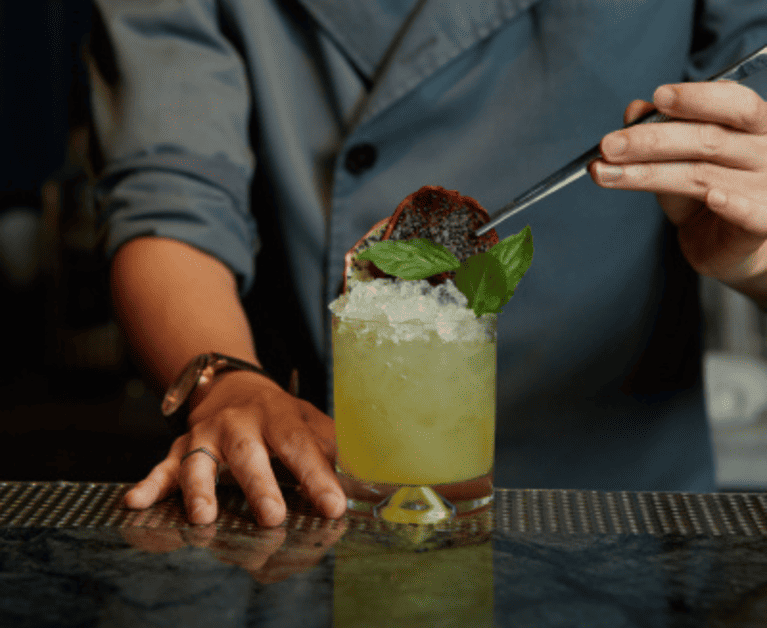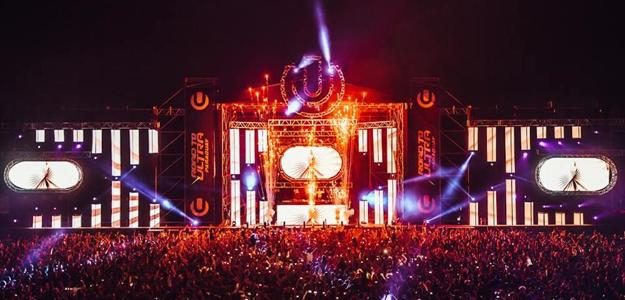Penang Island – Essential Travel Guide
PUBLISHED March 10th, 2016 07:00 am | UPDATED October 25th, 2022 12:47 pm
Known as “The Pearl of the Orient”, and more unofficially, the food capital of Malaysia, Penang is highly urbanised and industrialised, making it one of the most developed states in the Malay Peninsula.
The state consists of two parts, Penang Island (which this guide is about) and Seberang Perai, a small rectangular-shaped district situated on the mainland.
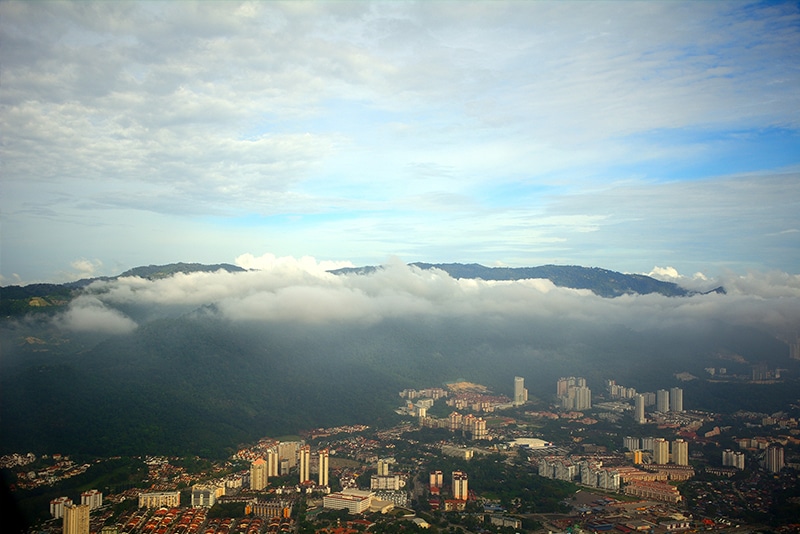
Home to some 700,000 residents, Penang’s beauty lies in its highly diverse ethnicity, culture, language and religion. You’ll find all of this most apparent in George Town, the capital of Penang. With a unique architectural and cultural townscape, it’s no wonder the city was gazetted as a UNESCO World Heritage site in 2008. Other sites of interest in Penang Island include the city of Bayan Lepas in the southeast, and Batu Ferringhi, the northern coast famed for its abundance of beaches and resorts.
Climate
The warm and humid air is the first thing that greets visitors stepping onto the island. Just like other parts of Malaysia, Penang has an equatorial climate which means high heat, high humidity and high rainfall all year round. As an island, the heat is slightly worse than the mainland, with temperatures reaching as high as 35 Celcius during the day. Visitors can expect sunshine throughout most of the days, but also rainfall in the evenings.
- December – March: Dry season. Minimal rainfall.
- April – November: Wet Season. Strong Monsoon Winds.
While rainfall can be expected all year round, the driest months are January and February while October is the coolest month of the year.
Getting there and away
Air. Getting into Penang Island is relatively easy, with many airlines (Malaysia Airlines, Thai Airways, Cathay Pacific, AirAsia, Jetstar Airways, Tiger Airways, Fireflyz, Silk Air, and China Airlines) flying direct. The only airport is the Penang Bayan Lepas International Airport, located on the southeastern coast of the island.
Land. It’s also possible to take a bus in from Johor, Kuala Lumpur, Singapore, and Thailand as the island is connected to the mainland and the North-South Expressway by the Penang Bridge. Usually congested in the morning and evenings. There is no toll for vehicles heading to the mainland, but vehicles (motorcycles, cars, vans, and buses) headed to the island must pay a small toll depending on the vehicle type.
Sea. Penang Port operates ferries from and to Butterworth (Sultan Abdul Halim Terminal) every 15 minutes from 5.30am to 1am daily. Ferry ends at the Raja Tun Uda Terminal at Weld Quay.
Getting to and from Penang Bayan Lepas International Airport
A 30-minute ride away from George Town, buses 401 and 102 run from the airport to the KOMTAR bus terminal for an onward journey to other parts of Penang. The bus stop is in front of the arrival hall. When coming in from KOMTAR bus terminal to the airport, you can take buses 401, 401E, and 102 from Lane 5. Be sure to have exact fare (RM2.70) as bus drivers are not able to give change.
Getting Around Penang Island
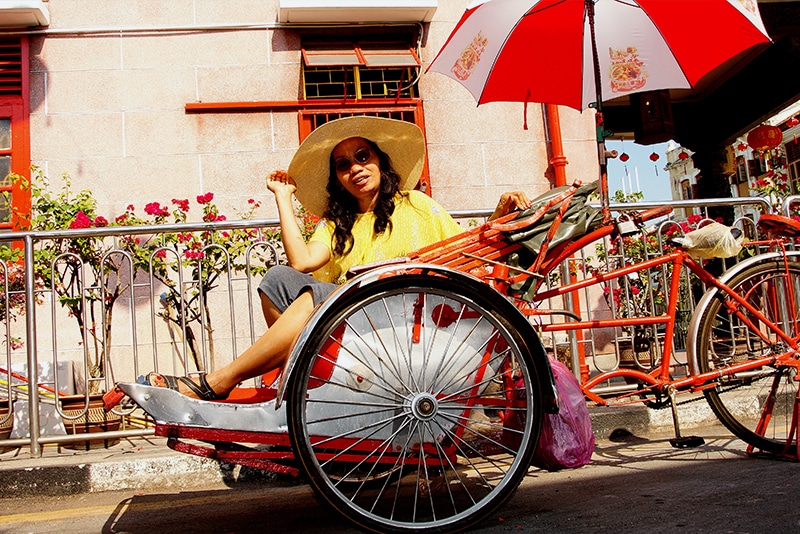
By foot or bicycle. One of the best ways to check out George Town is to explore on your own, either by walking or on a bike. Start early in the morning (with lightweight clothing) There are plenty of walking tours available by local residents, simply ask your hotel or guest house for recommendations.
By trishaw. Ubiquitous throughout the city, these human-powered vehicles are the next best option for a city tour. Negotiate a fixed rate with the driver before getting on, and it is best to hire them by the hour (the going rate is around RM30 per hour). Many of the drivers are also excellent tour guides.
By car. Planning to get out of the city? Rent a car, get off the beaten path, and explore the more rural parts of Penang. Do note that the island has a lot of one-way streets and very narrow roads, which can be difficult for inexperienced drivers. Motorcyclists don’t give way to cars, so be careful when driving. Try to avoid the rush hours between 7am to 9am, and 5.30pm to 7.30pm.
Taxi. Even though most taxis are equipped with meters, many drivers are reluctant to turn them on. Thus, be sure to haggle with the driver on the price beforehand. Avoid unlicensed and unmarked taxis, and basically any cars that do not look ‘official’. Alternatively, there’s also Uber in Penang.
Where to stay in Penang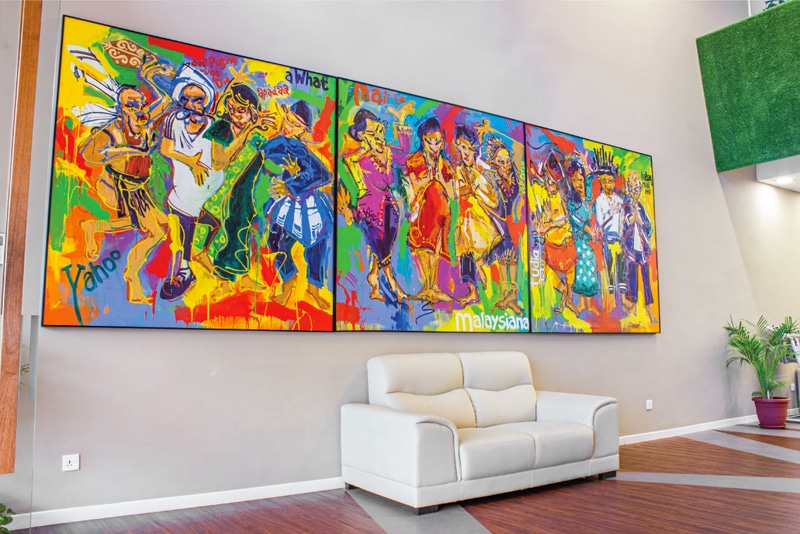
Budget Hotels (Less than US$25 per night)
75 Travellers Lodge ($5-12 USD per night) – Dorm, single, and double rooms. Prime location, right in the middle of Chinatown. Located at 75 Lebuh Muntri.
Hostel Red Inn ($7-22 USD per night) – Dorm, single, and double rooms. New and stylish hostel with laundry service and breakfast. Located at 55 Love Lane.
Reggae Hotel and Guesthouse ($8-10 USD per night) – Dorms only. Beds have individual ‘stalls’ with curtain for privacy and a small mirrored cabinet. Located at 57 Love Lane.
Wassup Youth Hostel ($9-25 USD per night) – Dorms, double, and triple rooms. Pool tables and free usage of computers. Located at 495E Jalan Penang.
Old Penang Guesthouse ($6-20 USD per night) – Dorm, twin, and double rooms. A modern fitout in a historic heritage building. Lovely courtyard, with laundry service and tour desk. Located at 53 Love Lane.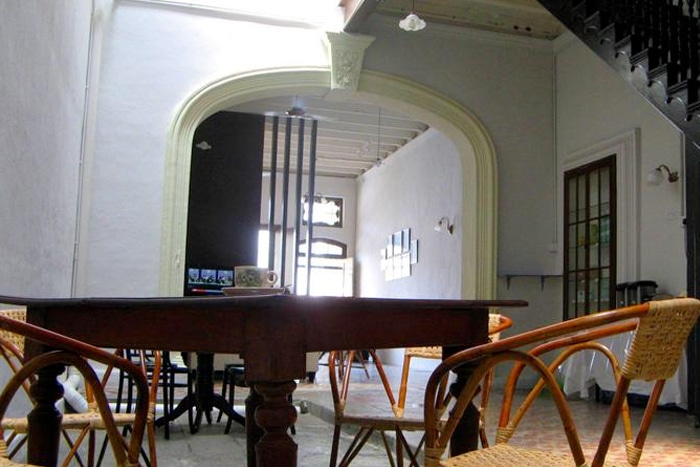
Mid-range Hotels (US$25-100 per night)
Traders Hotel Penang ($60-100 USD per night) – A premier business hotel conveniently located next to KOMTAR and Prangin Mall, and only 15 minutes away from the airport and Bayan Lepas Industrial Zone. Located at Magazine Road.
Hotel Chulia Mansion ($40-90 USD per night) – Established with an environmental-friendly concept, this very modern hotel is located right at the core of George Town. Located at 413 Lebuh Chulia.
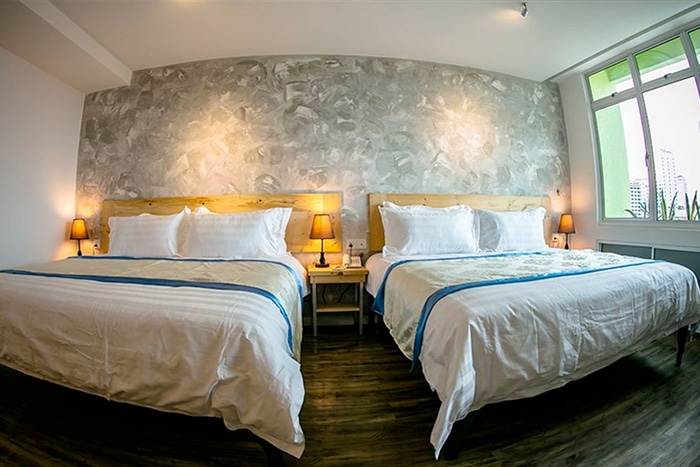
Tune Hotel ($35-50 USD per night) – Close to the Gurney Drive sea promenade, this hotel is only 8km from the grand Kek Lok Si temple and 10km from Penang hill. There are a variety of eateries within walking distance. Located at 100 Burmah Road.
Dou Houz Guest House ($40-65 USD per night) – Artsy guesthouse with 2 and 3-storey ‘lofts’. In-house restaurant, complimentary bicycle rental, and private bathroom. Located at Lebuh Noordin.
Cintra Heritage House ($40-60 USD per night) – A shophouse-style boutique hotel featuring an eclectic southern Chinese decor. Built in the 1840s, the hotel once served as a hair salon for Japanese officers and local administrators. Located at 1 Lebuh Cintra.
Luxury Hotels (US$100+ per night)
Shangri-La’s Rasa Sayang Resort & Spa ($150-400 USD per night) The resort has a sense of history, place, and tradition, with its distinctive Minangkabau architecture. Stay at one of its eleven private villas, have a relaxing time at CHI The Spa, or have a game of miniature golf right by the sea. Located at Kampung Tanjung Huma, Batu Feringghi Beach.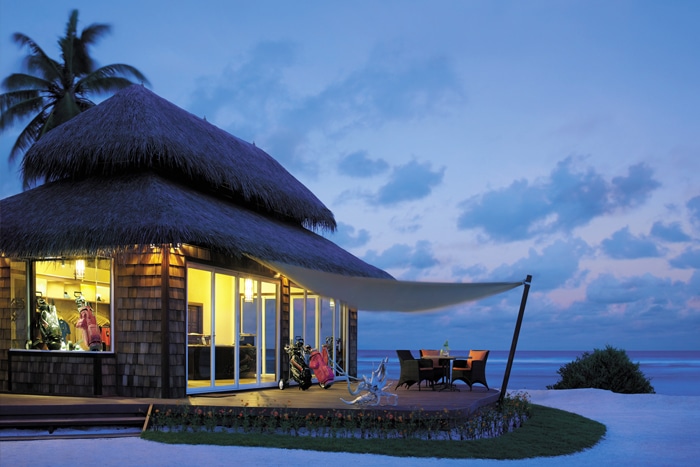
PARKROYAL Penang ($100-300 USD per night) – PARKROYAL resort is ideal for honeymoons and family getaways. Right in the middle of the night markets, it’s a few minutes walk away from a hawker centre. Located at Batu Ferringhi Beach.
Lone Pine Penang ($160-$390 USD per night) – Set in coastal gardens along the Malacca Strait, this upmarket beachfront boutique hotel is 15 km from the city centre. It has recently been rejuvenated after a long restoration. Located at Batu Ferringhi.
Eastern & Oriental Hotel ($100-180 USD per night) – Opened in 1885, this grand old colonial hotel is a quick ten minutes walk from Fort Cornwallis and 4km away from Gurney Plaza shopping mall. Located at 10 Farquhar Street.
Places to visit in Penang Island
George Town Street Art
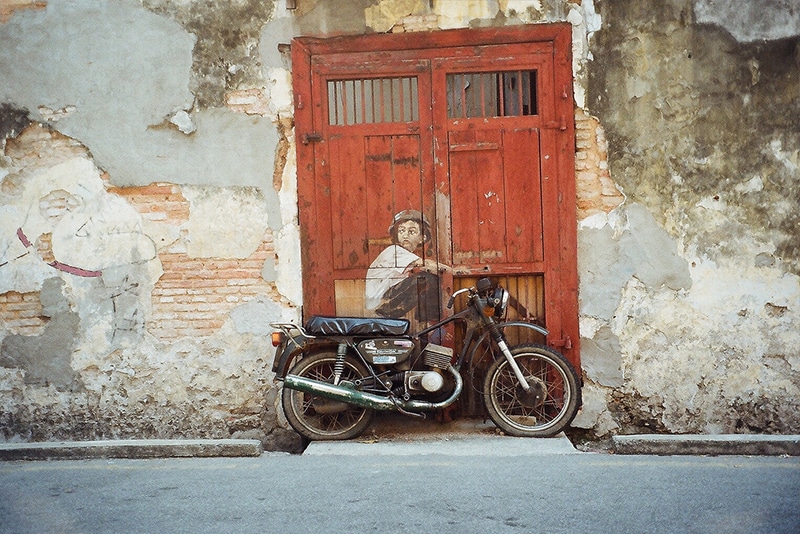
George Town became a UNESCO World Heritage Site partially because of the street art all around the city, particularly the murals by Lithuanian artist Ernest Zacharevic, the 101 Lost Kittens project by Thai artist Natthapon Muangkliang and Malaysian artists Louise Low and Tang Yeok Khang. There are a great number of works besides those listed above, some by random artists and others by local tenants. Every street has their own unique story. For more information, check out the Street Art Map by the Penang Tourism board.
Kek Lok Si Temple & Air Hitam Dam Treks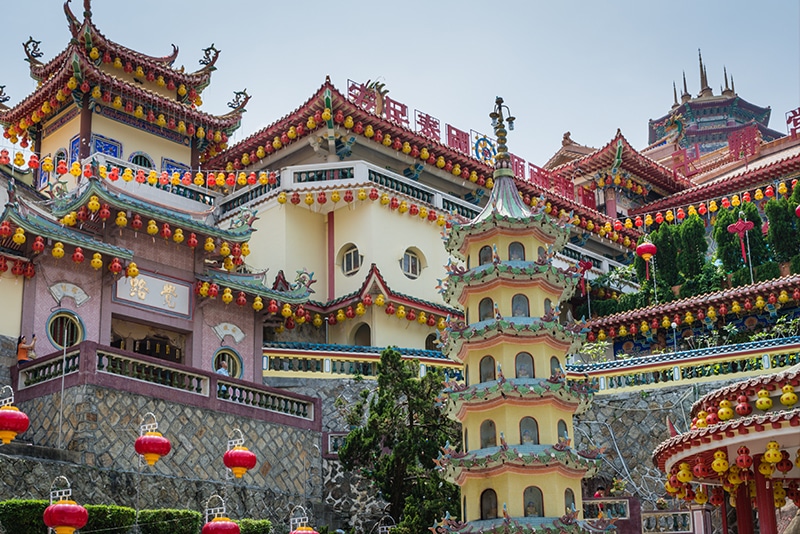
Perched on top of a hill overlooking the island’s northeastern coast, Kek Lok Si is one of the biggest Buddhist temples in Southeast Asia, with massive statues of the Goddess of Mercy. Feeling adventurous? Head further uphill along the main road where you’ll find Air Hitam (which literally translates to ‘Black Water’), a huge water basin and volcanic caldera that lies at the very top of the mountain. Just beware the monkeys that may be looking for a free meal.
Balik Pulau’s Fishing Villages
Southwest of George Town, Balik Pulau is a beautiful oasis to experience the kampong (Malay village) life. Gorgeous hills, palm trees, fishing villages, and plenty of old world charm. Take a sunset stroll and have dinner at one of the street stalls, or just sit down to observe the slow pace life away from the city.
Teluk Bahang National Park
Gazetted as a nature reserve back in 1928, the Penang National Park boasts many hiking trails through virgin jungle. One of the most popular trails, which takes two and a half hours to complete, starts from the entrance of the Botanic Gardens, leading up to Penang Hill. Alternatively, hike along the coast to Monkey Beach and take a quick dip in the water before heading to an old light house (where you can also camp). Most of the hiking routes are suitable for beginners. You can take bus 101 from Chulia street or the city bus stand at KOMTAR.
Batu Ferringhi
This beach area is arguably the most developed stretch of land in Penang, due to the number of resorts. While the beaches aren’t the best in Malaysia, the sand is a lovely and powdery white and there are still miles and miles of palm trees. The night markets here are famous as well, selling everything from souvenirs to clothing, to mobile accessories. Watch out when swimming in the water as there’re jellyfish in the area.
Where to eat and drink
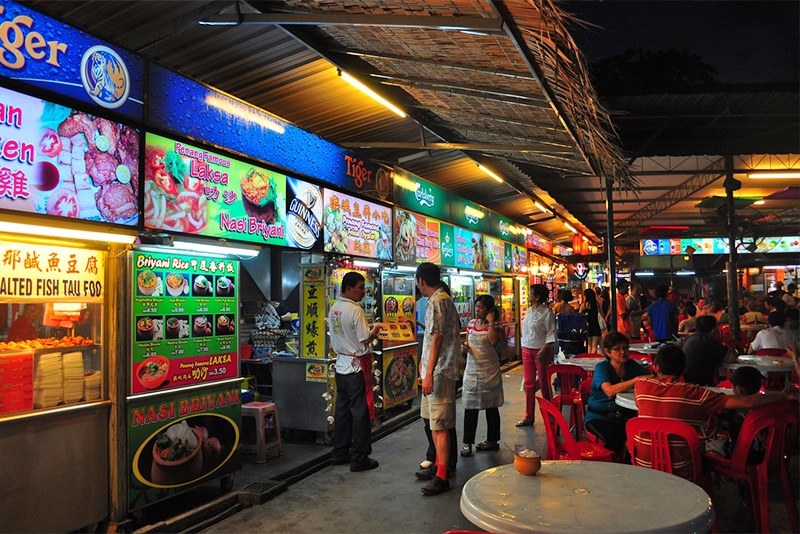
The culture and architecture in Penang Island are huge draws, but many also make the trip to Malaysia’s food capital for one reason only: to stuff themselves silly with the huge variety of delicious (and cheap) local dishes on offer.
Famous must-trys are the Char Koay Teow, Penang Laksa, Nasi Kandar, and Cendol, just to name a few. We’ve listed a number of our favourites, but you can be sure that there’s plenty more unknown ones that only the Penangites know about. So ask away when you’re there, and enjoy yourself in this food paradise.
Local Eateries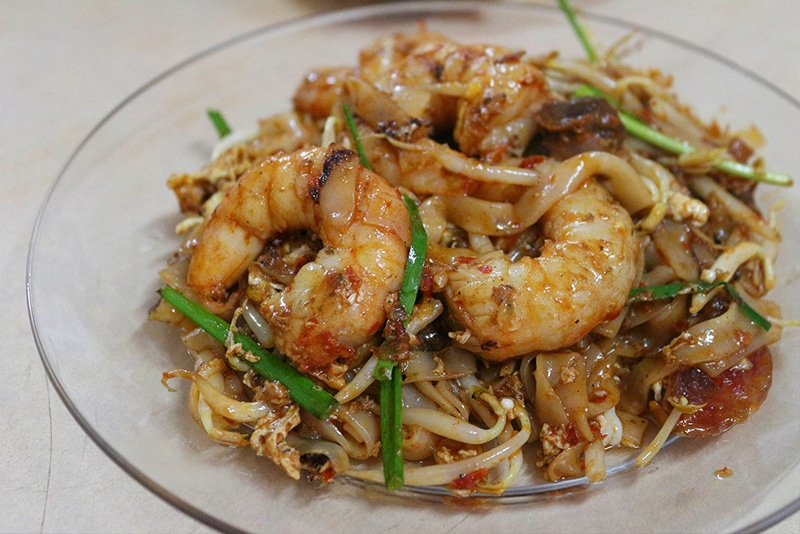
Char Koay Teow – Generous portions of prawn, seafood, duck eggs, and rice noodles skillfully fried together ‘wok-hei’ style on charcoal stoves. Compared to the Singaporean version, the Penang style is sweeter and lighter.
- Ah Leng Char Koay Teow, located at Restoran Tong Hooi.
- Tiger Char Koay Teow, located at 181 Lebuh Carnarvon.
Prawn Noodles – Also known as Hae Mee, this is a flavourful orange broth cooked by boiling prawn heads and pork ribs for hours, noodles, and deep fried shallot.
- Ah Soon Kor Har Mee, located at 168 Jalan Macalister.
- Hokkien Mee, located at Jalan Penaga Jelutong Night Market.
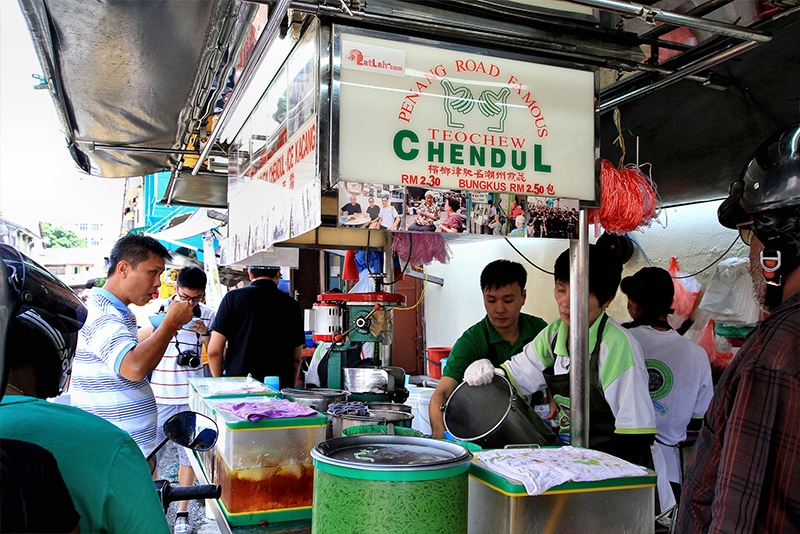
Cendol – Beat the heat with an icy bowl of pandan jelly, red bean, palm sugar, fresh coconut milk and shaved ice.
- Penang Road Famous Teochew Chendul, located at 27 Lebuh Keng Kwee.
- Pushcart Chendul Stall, located at 100 Lorong Macalister.
Laksa – There are many variants of Laksa in Asia, but Penang’s Assam Laksa is one of our favourites. Containing fish flakes and thick prawn paste, it’s a bowl of tangy, spicy, sweet, and savoury all in one.
- Joo Hooi Café, located at 475 Jalan Penang.
- Pasar Air Itam Laksa, located at Jalan Pasar.
Koay Teow Th’ng – Koay Teow Th’ng typically comes with slices of pork, fish balls, fish cake and a rich broth with flat rice noodles. You can request for duck to be used instead of pork.
- Fish Ball Koay Teow Soup, located at Lebuh Carnavon.
- Joo Hooi Cafe, located at 475 Jalan Penang.
Oh Chien – Basically potato starch fried with eggs and oysters, Oh Chien is a greasy, guilty pleasure.
- Lam Ah Coffee Shop, located at Lebuh Carnarvon.
- Kah Kah Fried Oyster, located at Lebuh Keng Kwee.
Wantan Mee – Penang’s Wanton Mee is, put simply, old-school. Springy noodles with thinly cut roast pork tossed in black sauce, not forgetting the very fragrant pork lard.
- Swee Kong Coffee Shop, located at Pulau Tikus Jalan Burma.
- Kwai Lock Coffee, located at 295-B Jalan Burmah.
Penang Rojak – Penang is famous for its fermented prawn paste, otherwise known as ‘hae ko’, the same sauce which is used for their rojak, a mixture of fried dough, beancurd puffs, and fruits like guava, mangoes, and green apples.
- Hock Seng Rojak King, located at Macallum Street.
- Kompleks Makanan Medan Renong, located at Jalan Padang Kota Lama.
Restaurants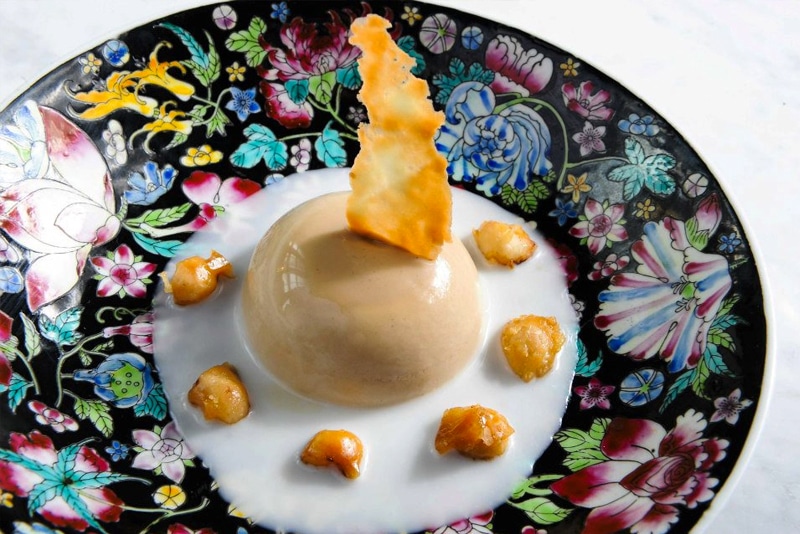
Soul Kitchen – An Italian-style eatery that is all about creating food for the soul. There are no printed menus here, and all dishes are cooked from scratch. Fresh, healthy, and simple. Located at 17 Jalan Phuah Hin Leong.
Kebaya at Seven Terraces – Decked out in true Peranakan style – mosaic tile floors, carved wooden furniture, and vases of lovely white orchids – the menu at Kebaya combines traditional Indo-Chinese dishes with French flavours. Located at Lorong Stewart.
El Faro – A tapas and wine bar with a refined take on the small plates trend. Possibly the best of Spanish cuisine in the George Town dining scene. Wines from Spain and Western Europe, and many New World ones. Located at 231 Burmah Road.
Western Spices – Contemporary western small plates packed with flavour, located in a scenic historic building. Think Mocha Lamb Ribs and Braised Duck with Beer Seasoning. Located at 1 Green Hall Road.
32 at the Mansion – Have a taste of royalty at the Leong Yin Kean colonial mansion along the north beach. The restaurant’s menu is endlessly surprising with a large appetiser and mains menu, complemented by a lounge setting with picturesque views of the beach. Located at 32 Jalan Sultan Ahmad Shah.
Bars
Talk Talk Wine Bar & Lounge – A spacious place to chill over a good selection of reds and white, or even beer with a friendly ambience and live music on the weekends. Located at Pekaka Square, Lebuh Pekaka Satu.
Three Sixty Rooftop Bar – One of the first rooftop bars in George Town, enjoy a cocktail high above the city while taking in gorgeous views of the city. Plus, the indoor portion of the lounge also does a slow 360-degree turn, hence the name. Located at 25A Lebuh Farquhar.
Bora Bora by Sunset -This beachside eatery has a strong selection of affordable bottled and tap beers, and while not particularly fancy in decor, has enough boho-charm to be appealing for both tourists and locals alike. Located at Lot 415, Jalan Batu Ferringhi.
Soho Free House – A long-standing British pub in George Town best-known for their all-day Happy Hour beer promotions and unpretentious crowd of expat-locals. Beautiful decor with colonial heritage elements. Located at 50A, Jalan Penang.
Cafes
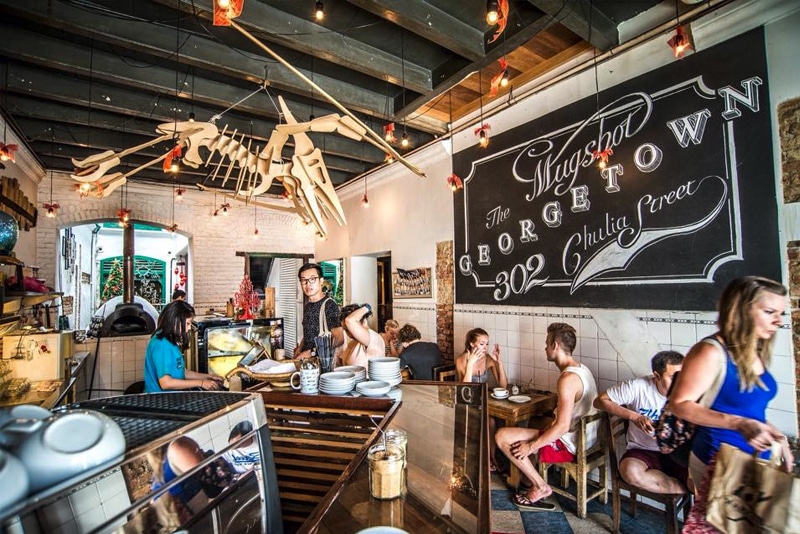
Although Penang is an island, it is no stranger to the cafe culture. In fact, the scene is practically bustling with new ones popping up every month or so:
Daily Dose – Good pan-continental food is the main draw here, with innovative daily specials every day of the week. There’s also a great selection of wine and fantastic coffee. Located at Lebuh Carnarvon.
Mews Cafe – Made from fresh local produce, the menu here is mostly inspired by Asian cuisine with a little bit of tasty international favourites. With both a cozy indoor and al fresco dining, beers and coffee is served all day long. Located at Muntri Street.
Mugshot Cafe – The menu here is far from extensive (coffee, bagels, and yoghurt), but it works well. Their coffee is sourced from a fairtrade ‘micro-roastery’ in KL called Espressolab. Located at Lebuh Chulia.
China House – Consisting of a bakery, wine bar, art gallery, theatre, and cafe, the compound spans across three heritage buildings linked by an open air courtyard. Known for their delicious cakes, you’ll find three eateries with separate menus. Located at Lebuh Pantai.
Cozy in the Rocket – A spacious cafe with an appealing antique and rustic decor. Semi-alfresco style with natural lighting, making it nice for relaxing over fresh pasta and coffee. Located at Lebuh Pantai.
Nightlife
Malaysian may be an Islamic country, but there are still options for a night out. Most nightclubs are concentrated around Upper Penang Road in George Town: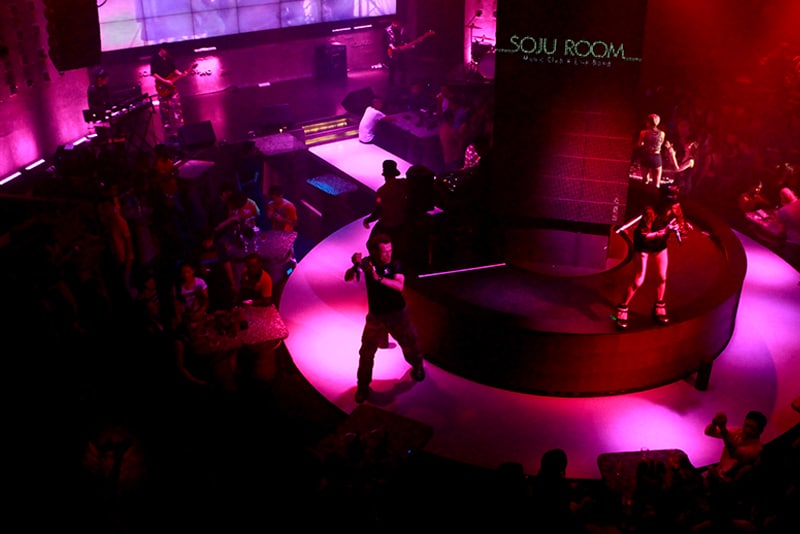
Soju Room – A great place for those into pure electronic dance music from the biggest names on the charts. With other outlets in Kuala Lumpur, Soju is arguably one of Malaysia’s best clubs. The music is loud, the drinks are strong, and the crowd is fun. Located at the basement of Penang Times Square.
Slippery Senoritas – The music selection here is quite diverse with a good mix of tunes from all genres, including salsa, as the name implies. The club has live music acts from local bands on most night, and has highly skilled bartenders who flair their skills in the air. Located at No. 2 Jalan Penang.
M2 – It’s Asian-style all day everyday as a rotating roster of Chinese, Japanese, Taiwanese, and Korean DJs come in to take the decks. Don’t be surprised to hear K-pop hits fused with house dance tracks, which results in a groovy dance floor. Wednesday is free entry for ladies. Located at the basement of Penang Times Square.
Shopping
Malls
Gurney Paragon – One of Penang’s newest shopping malls, it’s a blend of fast fashion and luxury brands here, with a dedicated IMAX cinema operated by Tanjung Golden Village. There’s also about 30 restaurants fronting the al fresco facade. Located at Gurney Drive.
Gurney Plaza – Right next to Gurney Paragon, the huge nine-story Gurney Plaza is one of Penang’s most popular. You’ll find a Cold Storage supermarket, some 60 restaurants and a 12-screen cinema. Located at Persiaran Gurney.
1st Avenue Mall – A relatively new mall located in the heart of Georgetown, this place is great for some onsite entertainment—a cinema, bowling alley, internet cafe, karaoke centre, snooker bar, and an Escape Room outlet. Located at Jalan Magazine.
Queensbay Mall – The largest mall in Penang, Queensbay is also situated near the international airport. Offers a Borders bookstore, Aeon (formerly JUSCO), Harvey Norman and a wide variety of fast fashion chains. Located at Persiaran Bayan Indah.
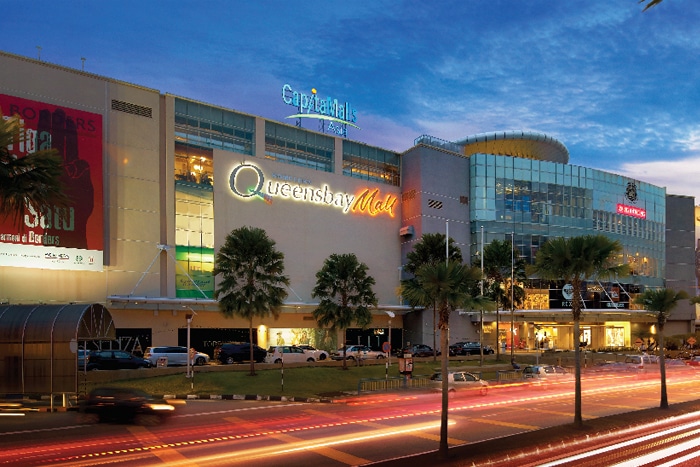
Prangin Mall – Despite being one of the older malls in Penang, Prangin is constantly upgrading and picking up on new trends. The ground floor is populated with stores selling cheap electronic goods, while the rest consists mostly of small local fashion boutiques. Located at Jalan Dr Lim Chwee Leong.
Outdoor Markets
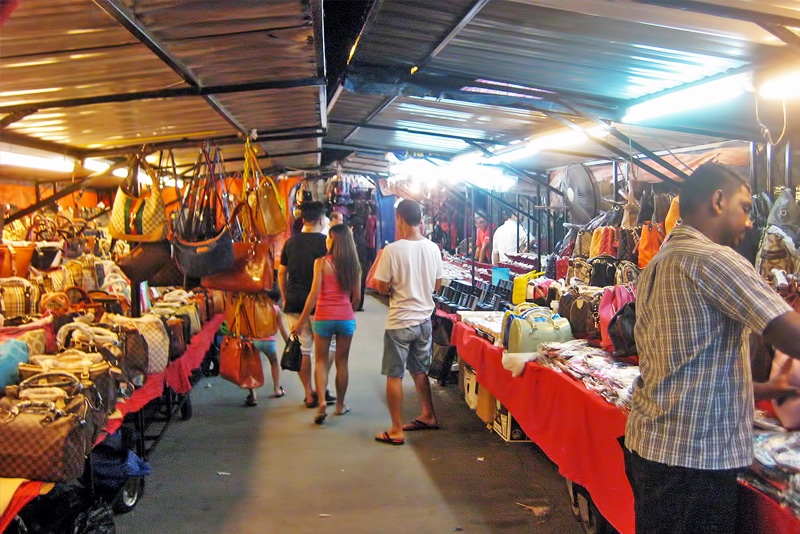
Lorong Kulit Flea Market – Stalls selling everything from fruits and vegetables to antiques and vintage. Great for seeing the local atmosphere. Open early morning to 1pm next to City Stadium.
Batu Ferringhi Pasar Malam – Daily night market with accessories, souvenirs, clothing, bags, and jewellery. Open 8pm – 12am along Batu Ferringhi.
Little Penang Street Market – Monthly market showcasing Penang’s creativity and heritage. Open 10am – 5pm on the last Sunday of every month at Upper Penang Rd (near E&O Hotel).
Baked Goods
Famous throughout Malaysia for its Chinese bakeries, Penang’s baked goods and pastries make great souvenirs for friends, colleagues, and family.
Ghee Hiang – The oldest bakery in Penang (established in 1856!) and also the best biscuit makers. Signature product is the tau sar piah (mung bean paste biscuit)
Loong Nam & Co – Biscuit specialist shop in operation since 1928. Signature products are their roti jari and roti kapai.
Ng Kee Cake Shop – Sells Cantonese traditional biscuits. Signature product is the ham chit soo (pepper biscuit).
Him Heang – Arguably the most famous Chinese bakery in Penang. Signature product is the beh teh saw (horseshoe pastry)
Festivals
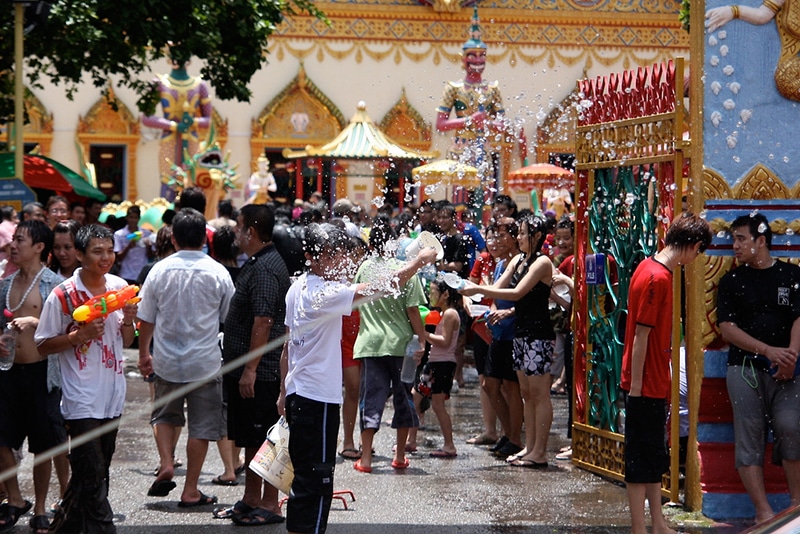
Penang’s treasure is its multi-cultural society, which also means an abundance of religious and cultural festivals for every to join in the fun:
Chinese New Year (January/February) – Major Chinese festival celebrating the Lunar New Year. Fourteen days later (during the full moon), the ‘gods’ from numerous temples are brought out for a procession around the island.
Thaipusam (February) – Extraordinary Hindu festival to celebrate the moon at its fullest, and the streets are filled with music, drums, and large floats dragged by young men to the Hindu temple.
George Town Festival (June) – A month long festival celebrating art, music, theatre, dance, opera, and film, possessing a lovely blend of local and international cultural showcases.
Penang Floral Festival (June) – Beautiful floral carnival held at the Penang Botanic Gardens annually.
Bon Odori Festival (July) An annual festival with over 80 stalls celebrating Japanese culture with performances, games, and delicious Japanese cuisine. Fireworks are displayed in the evening.
Hungry Ghost Festival (September) According to Chinese superstition, the gates of hell are open during this month-long festival where the King of Hell’s army of hungry ghosts enjoy the food, prayers, and entertainment set out by the living. Chinese opera performers and pop-shows are abound during this period.
Day Trips from Penang
Want to get off the island? Take a day trip out or head to one of these places for the next leg of your holiday:
Pulau Aman
A five-minute boat ride (costing RM6) away from the Batu Musang Jetty is Pulau Aman, a small island between the first Penang Bridge and the new bridge. Many locals come here to enjoy the seafood, especially the Mantis Prawns, which are relatively cheaper than that on Penang Island. A must try is Mee Udang, which basically translates to Prawn Noodle. There’s also a number of hiking trails and awesome spots for fishing here.
Butterworth
The main town on the mainland side of Penang, Butterworth has the largest bird park in Malaysia as well as the Temple of the “Ninth Emperor God”, a very beautiful temple that is decorated for the annual Nine Emperor Gods festival every ninth month on the Chinese Lunar Calendar. There are various cafes in Bandar Sunway, and many Chinese restaurants along the road to the sea.
Taiping
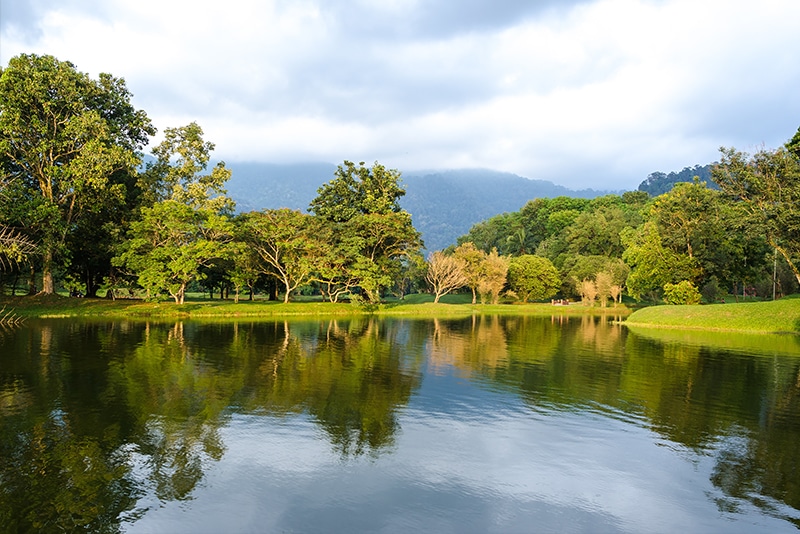
Travel inland towards northern Perak to Taiping, a town known for cheap and delicious hawker spread likes Curry Mee, Lobak, and Peanut Soup. Enjoy the snacks and street foot as you stroll through town, and perhaps spend some time in the Lake Gardens, a place for relaxing and photography. You can even rent a boat and paddle in the lake. Taiping is also home to the oldest museum in Malaysia, Museum Perak, and the Taiping Zoo.
Langkawi
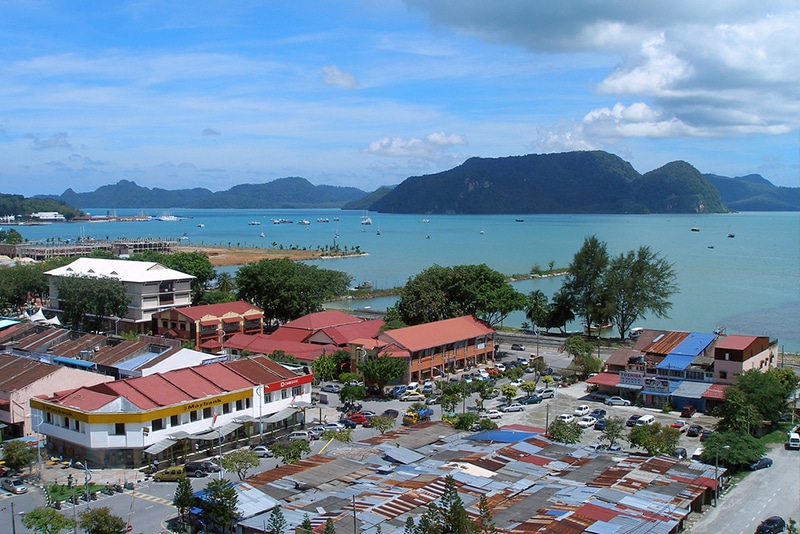
Langkawi Island is a fantastic place for nature lovers, with a shoreline fringed with powder-fine sand and tall coconut trees. Walk in a little towards the jungle and you’ll find huge paddy fields and picturesque hills to climb. Three-hours away from Penang by ferry, the island also attracts visitors for its scenic dive spots, seafood restaurants, and bars. Oh, did we mention duty free alcohol, cigarettes, and chocolates?
Hat Yai
Minivan services to Hat Yai is available on a daily basis from George Town’s Lebuh Chulia and are usually quite affordable. The fourth largest city in south Thailand is an extremely popular tourist spot. See a dentist (Prince Songkhla University’s faculty of dentistry offers very reasonably priced treatments), go for a Thai massage, visit the many shopping malls there, or simply stuff your face with some spicy Southern Thai food.
Essential Tips
Food and Drink
The food safety level in Penang is generally good. As the food paradise of Malaysia, there is just too much competition around for vendors to skimp on quality and hygiene. If you have a weak stomach, you may want to avoid fresh salad and fruits left in the heat. Also be careful with unbottled water from hawker stalls. Take care with products that are made from milk, which may or may not be pasteurised.
Language
Nearly all residents in Penang are able to speak Malay, the national language of Malaysia, but English is spoken fluently by most professionals, business people, and locals under the age of 30 (English is a required language subject in Malaysian schools). Ethnic Chinese form the majority in Penang, and they usually speak in Mandarin, Cantonese, and Hokkien to each other. Similarly, ethnic Malays and Indians converse in Malay and Tamil. Basic English (albeit broken) is understood by elderly residents, but when in doubt, use your hands to point and gesture, or approach a younger local for help.
Religion & Culture
While Islam is the official religion in Penang, other religions are freely practiced in this multi-cultural state. Chinese Buddhism is the main religion, due to the fact that the Chinese are the dominant group. Many Indians, especially immigrants from the southern states, are Muslims as well. The Chinese are mostly Hokkien, with a smaller group of Cantonese and Teochew people.
Society
The residents in Penang are really friendly and there is a homely sense of community on the streets, especially in George Town. Everyone wants to help and everyone smiles, so you’ll never feel alone here.
Safety
Like most Southeast Asian cities, Penang can still be dangerous. Avoid walking alone in deserted areas, alleys, and streets, especially after dark. In Penang, the major tourist crime is bag-snatching, usually carried out on motorcycles, followed by ordinary snatch-thefts and muggings. Suburbs like Jelutong are reported to have higher crime rates, but these are usually at non-touristy spots.
Be wary of strangers offering free rides and avoid unlicensed unmarked taxis, known as Kereta Sapu. When swimming or playing in the beaches (such as Batu Ferringhi or Pantai Kerachut beach), watch out for jellyfish (including the rare venomous box jellyfish) during the monsoon season.
In all, Penang is a fantastic place to eat and relax, so don’t be too paranoid and just enjoy the island.
Reccommended length of stay in Penang Island: 3 – 4 days.

